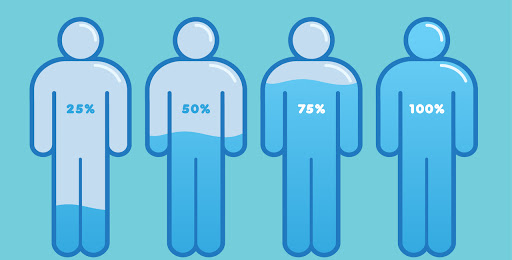
Water is one of the most important elements for all living things. Up to 60 percent of the human adult body is made of water. It’s essential for biochemical reactions, supplying nutrients throughout the body and removing waste, and maintaining blood circulation and body temperature. It aids in digestion, prevents constipation, cushions joints, stabilizes the heartbeat, and protects vital organs and tissues.
Without it, or without enough of it, we can become dehydrated. Dehydration might show itself in the form of muscle cramps, fatigue, thirst, and other unpleasant symptoms. Our thinking and cognition can suffer. We might lose appetite, experience mild constipation and lightheadedness, or kidney stones. Your body needs more water when you’re in warmer climates, physically active, running a fever, and having diarrhea or vomiting.
Delight in every bite
According to doctors, there’s no one-size-fits-all formula for daily water intake. The amount of water you should drink daily depends on your body, your health conditions, your medications, and other factors. Certain conditions like thyroid disease or kidney, liver, or heart problems make it possible for some people to have too much water, while some antidepressants and non-steroidal anti-inflammatory drugs (NSAIDs) make people retain water. There is no standard for how much plain water adults and children should drink daily, though there are general recommendations for both women and men. Here’s one rule of thumb: women should drink approximately 2.7 liters of water each day while men should average 3.7 liters of total water. The key to staying safe and healthy this summer is staying hydrated.
Drink water
According to experts, daily fluid intake recommendations vary by age, sex, pregnancy, and breastfeeding. Start by drinking a cup of water each morning when you wake up or a glass before bed. Have another glass with every meal. Drink one or two cups after working out. To ward off dehydration, drink fluids gradually throughout the day.
Signs of dehydration
Experiencing a headache or feeling dizzy, irritated, inflamed, itchy, sensitive or fatigued? These are signs of dehydration. Muscle cramps, rapid breathing, fainting, and not urinating (or having very dark yellow urine) are others. If you’re experiencing any of these symptoms, the simple solution is to get out of the heat and drink plenty of liquids.
Urine Color
A good measurement of hydration is the color of your urine. Pale urine, similar to the color of straw, indicates proper hydration while darker urine is a sign that you need more water. A dark yellow or amber color means you may have mild to severe dehydration. Of course, other medications and health conditions could affect this.
Liquids work against hydration
Some liquids work against hydration. Drinks like coffee, sugary sodas, beer, wine and hard liquor, lemonade, sweet tea, energy drinks, smoothies, and flavored milk are all culprits. They are loaded with sugar, sodium, and other ingredients that remove water from your tissues. Consider swapping some of these out daily or rehydrating with more water for each dehydrating drink you consume.
Cooldown
Proper hydration is about regulating your body temperature too. During summer, when the risk for heatstroke is at its highest, wear light, loose-fitting clothing in light colors; schedule strenuous sports and physical activities during cooler times of the day; protect yourself from the sun with hats and other shade accessories; take drink breaks often; and mist yourself with a spray bottle if you become overheated.
Eat foods with high water content
Approximately 80 percent of our water intake comes from drinking water. The other 20 percent comes from food. All whole fruits and vegetables contain some water, but snack on these for maximum benefit: cucumbers, celery, tomatoes, radishes, peppers, cauliflower, watermelon, spinach, strawberries, broccoli, and grapefruit. They all contain 90 percent water or higher.






0 Comments